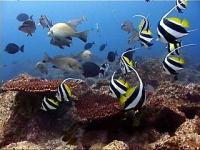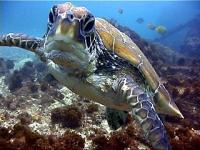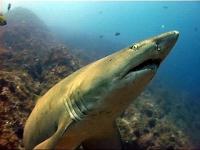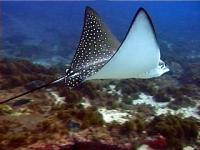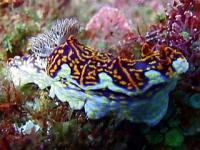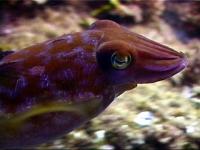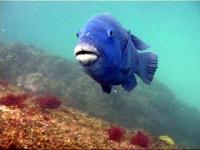Cape Byron Marine Park
Julian Rocks – A Marine Sanctuary Not To Be Missed
According to a story from the Bundjalung people a jealous husband threw his spear at the canoe of his wife and her lover. The canoe broke in two and sank to the bottom of the ocean. Only the back and the front of the boat stuck out of the water, creating a rock formation just 2.5 km off shore.
Named by Captain Cook in 1776, Julian Rocks in Byron Bay consists of ancient sedimentary rock, remains of a volcanic eruption more than 20 million years ago. It is an extension of Cape Byron separated by water and forms a most unique marine reserve, providing shelter and food for more than 500 tropical and temperate fish species alone!
From the 1st of December 2002 Julian Rocks has become part of the Cape Byron Marine Park and in May 2006 the new Marine Park zoning plan has come into action which amongst other things means that an area of 1500m around Julian Rocks has become a Sanctuary Zone for most of the year. This will hopefully see fish stocks replenish and give the critically endangered Grey Nurse Sharks some well deserved additional protection.
Not only does Julian Rocks provide resting and nesting grounds for many seabirds, such as seagulls and cormorants, underneath the water is an invisible world with abundant marine life present.
With water temperatures and currents changing throughout the year there are many seasonal visitors. The grey nurse sharks come to Julian Rocks during the winter months, presumably to breed. Although these sharks look ferocious with their mouths slightly opened and their teeth sticking out, it is perfectly safe to dive with them.
In spring the blue tang pays Julian Rocks a visit. This is a fish, which can be easily distinguished by its blue body and bright yellow tail. Schools of big-eye trevally are most common in summer.
The docile leopard sharks can be seen on almost every dive during mid-summer when the waters are warmest. The spotted patterns on their skin gives them their name. Most of the time they lie resting on the sand, but if you are lucky you can see them swimming, moving their long tail slowly.
In summer and early autumn manta rays cruise elegantly through the waters surrounding the rock. Sometimes feeding and definitely curious they are fantastic to encounter.
And then there are of course the ‘regulars’ like different species of wobbegong sharks, turtles, cuttlefish (family of the octopus), schools of white spotted eagle rays, egg-cowry shells, moray eels, banner fish, giant guitar fish and shovel-nose rays. Sometimes there are so many fish around, you can hardly see where you are going. Not to mention all sessile animals (attached to substrate) like tunicates, colourful sponges, both hard and soft corals, giving you the feeling you are floating through some beautifully landscaped underwater garden.
The Rock also forms a home for rare species such as the leaf scorpion fish, the pineapple fish with bioluminescent organs under its eyes, the shy blue devil fish, white banded anemone fish and a species of nudibranch previously thought not present in Australian waters: Noumea labouti. (A nudibranch is a colourful underwater snail without a shell, carrying its respiratory organ on its back)
The interaction of tropical and temperate species makes every dive an exhilarating adventure. The three minute boat trip to the rock is almost as exciting: surfing the waves sometimes accompanied by playful dolphins. From May till September the Humpback whales come past Byron Bay and can easily be spotted from the boat. With water temperatures up to 25 degrees Celsius and visibility of 20 meters at most times there is really nothing to complain about.
Fortunately the dive operators in Byron Bay also realise the value of this Aquatic Reserve. Moorings have been put in place and are taken care of, so destructive anchors are not needed. And since there are only a limited number of commercial vessel launching licences available, no over-diving can take place.
All different dive sites around Julian Rocks are equally impressive and offer dives that are spectacular for the novice and the very experienced underwater explorer!
Julian Rocks Marine Reserve is only a few minutes boat ride from the Main Beach. Tropical and temperate currents meet here, resulting in an unique mixture and incredible abundance of marine life.
Other spectacular dive sites around Byron Bay include Spot X, Mackerel Bowl, Cape Pinnacles and Middle Reef.
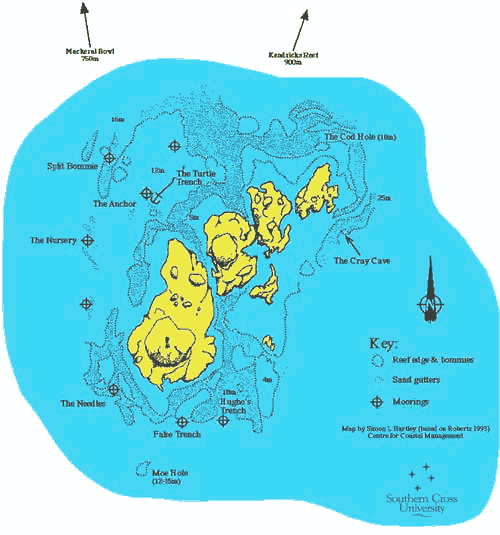
This picture is courtesy of Simon Hartley , Associate Lecturer at the Southern Cross University in Lismore. Please note that this picture is copyrighted and permission should be sought from Simon before downloading or using it.


